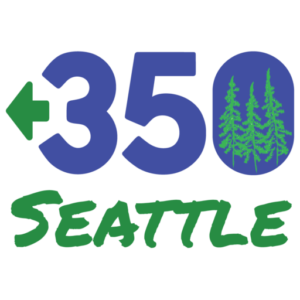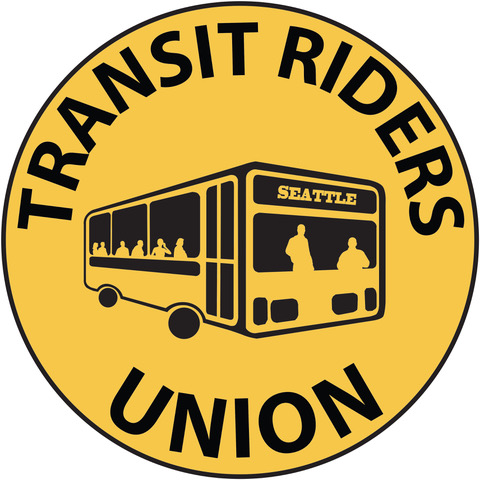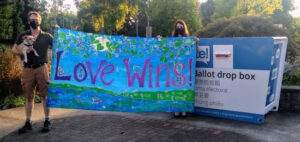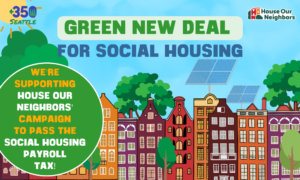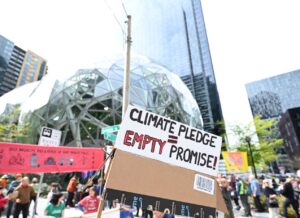 . .
. . 
Dear Mayor Durkan:
Congratulations! We look forward to working with you to make Seattle a world-class city that’s leading boldly on climate, transportation, and livability. The city is at a crossroads: can we preserve and foster socioeconomic diversity, or will those who aren’t wealthy be forced out? Can we build a carbon-free transit system that rapidly reduces our dependence on private vehicles, clears the air, and makes room for pedestrians? Can we do these things in a way that inspires other cities? We believe we can. But we have to act urgently, because “winning slowly is the same as losing.”
In the Seattle Mayoral Forum on Arts and the Environment, you said you hoped that a headline at the end of your first term would read “Seattle led on greenhouse emissions, and…we really are the spearhead by not just what we do here in Seattle, but how we show how it can work everywhere else.” We fully support your commitment to this boldness, and urge you to consider the following approaches.
TRANSPORTATION: BUILD A CITY THAT PROMOTES WALKING, BIKING AND TRANSIT
The shaping of neighborhoods and streets touches on many vital priorities: improving public safety and health; strengthening community, economy and culture in neighborhoods; and establishing a resilient transportation system that does not add to global warming or pollute our air.
Promote dense, culturally vibrant neighborhoods that encourage walking, cycling, and transit. Walkability is the backbone of a resilient, non-polluting transportation system. The research is clear: dense, walkable, cycling-friendly neighborhoods that mix rather than segregate land uses promote public health, and support both community engagement and small business. Seattle has begun reducing off-street parking requirements and increasing residential zoning densities in many areas of our city with access to transit. These efforts need to be continued and expanded. In the “walkshed” of such neighborhood centers, the city should improve sidewalks and bike lanes, eliminate off-street parking requirements, set aside open space for community gathering, and implement dense and mixed-use zoning.
Fix our failing pedestrian and bike routes. Over 850 miles of city streets have no sidewalks, and many existing sidewalks are plagued with maintenance problems. Much of the city lacks safe bicycling routes. We need to expand our protected bike lanes. And we need to stop setting bike lanes and transit as opposing options for use of street space, as the Seattle Department of Transportation is unfortunately doing with Rainier Avenue planning. Alternatives to private vehicles should be taken from space those vehicles now occupy, whether by reducing parking or lane sizes. The latter has the additional benefit of traffic calming, thus making pedestrians and cyclists safer and supporting our Vision Zero commitment.
Continue working to bring down the speed of cars. Road diet projects and narrower lanes have shown that we can improve safety with relatively simple re-striping. We can also work creatively to shift the culture of driving. As European cities like Barcelona have shown, prioritizing pedestrians, cyclists, and street life changes driver behavior.
Accelerate Commute Trip Reduction. Encouraging and incentivizing commuters – and everyone traveling through our city – to use modes other than single occupancy vehicles (SOV) is one of the most effective ways to reduce both greenhouse gas emissions and traffic congestion. We urge you to aggressively expand Seattle’s Commute Trip Reduction program; think of creative ways to get unlimited transit passes into people’s hands, including mandating employer transit subsidies; and consider changing the regulation and taxation of employer-provided parking programs to make driving alone to and parking at work every day a less attractive option. Although rideshare systems such as Uber and Lyft may appear to be alternatives to SOV commuting, we are highly skeptical of their ability to accomplish the goals of reducing greenhouse emissions and congestion. Studies show the reverse effect. We urge you to be skeptical too.
Speed up transit improvements voted by the public. Seattle can’t afford to wait to build the transit infrastructure improvements that voters have approved. While we applaud Sound Transit’s changes to the planning process that will help shorten the time it takes to build these projects, there is more Seattle can do. We ask that the City use its bonding capacity to finish Sound Transit 3 construction projects sooner than currently planned. Additionally, the Council should make changes to Seattle’s permitting process that would make light rail an approved use, rather than an exception which requires project-by-project review. Changes such as these will help move the completion dates of these light rail projects ahead by years, and provide access to rapid transit to people across Seattle.
Improve access and safety around light rail stations. We ask you to instruct the SDOT to work closely with Sound Transit to prioritize safe, non-motorized access when using Seattle’s portion of the $100 million System Access Program (SAP) that was approved by the Sound Transit board in 2014. The SAP is intended to allow Sound Transit to improve multi-modal access around existing stations and provide funding for safe sidewalks, protected bike lanes, shared use paths, improved bus-rail integration, and new pick-up/drop-off areas.
Numerous light rail/pedestrian and light rail/auto collisions have taken place at at-grade stations from Sound Move and ST2 projects, proving that the safety features currently in place are not good enough. For Seattle’s portion of the SAP, SDOT and elected officials need to work with Sound Transit to make lasting and impactful changes around stations. Where needed, SDOT will need to install crosswalk markings, raised intersections, and other traffic calming measures; install and improve signage and wayfinding materials; align and orient ADA ramps with crosswalks; relocate utility cabinets and poles; and prioritize protected bike lanes around light rail stations.
To make sure that we do not have the same issues for ST3 projects, SDOT must set safety metrics and multi-modal access standards between now and early 2018, when guidelines for station access are being finalized, and are able to make the best use of ST3’s Station Access Allowance.
HOUSING: PROMOTE INCREASED OPTIONS FOR AFFORDABILITY.
This is a fight for the soul of Seattle, as well as an urgent climate justice concern. Around 1,600 new residents are already arriving monthly, and the Northwest will be one of the least climate-impacted places in the country in coming decades—we will need to grow to accommodate many more people, Will Seattle continue to displace lower-income communities and communities of color to further-out areas where public transit service is weakest? Or will we rise to the occasion and plan for growth in ways that benefit everyone and respond creatively to the urgent need for zero-carbon homes and transport?
We cannot achieve this without increasing density significantly. Almost 75% of our city’s nonindustrial land is zoned “single-family” rather than the more flexible “residential”. If we wish to have both affordable housing and green space, we have to build up, and in (the yards of existing homes). But allowing development to proceed without clear guidance and regulation means a profit-seeking free-for-all, in which low-income renters are displaced from homes they may have lived in for decades, to make way for glossy new market-rate rentals or townhouses.
A lot that houses ten families in townhouses instead of one in a single-family home helps to reduce the upward pressure on rents and home prices—those ten families would have lived somewhere in the city, so if they displace one family through development rather than 10 families in existing homes, then overall this does exert less pressure on lower-income residents. But it hurts not only the one family that is displaced; it also hurts the community, because market-driven development is inexorable, and drains neighborhoods of lower- and middle-income people, immigrants, students, artists, service workers, etc.—often the very people who have often given the neighborhood the “character” that attracted people in the first place.
We can increase density while minimizing displacement. As mayor, you must take the lead in offering creative solutions:
Make sure that changes to density are enacted equitably. Too often, lower-income neighborhoods with less political clout have been the first or only places that have been up-zoned. This is a travesty, and has resulted in an understandable mistrust of development itself. If people see that density is being increased citywide—and see the benefits that can come with that—there can be a sense of a shared project of healthy city evolution, rather than an exploitation of certain communities so that others might remain exactly the same.
Incentivize community ownership, and move toward public housing development.Limited equity co-ops, affordable cohousing, and ownership of housing stock by neighborhood groups and the city, especially on city-owned surplus land, are all creative and proven methods of moderating a growing market so that it continues to work for existing residents. The city should immediately undertake an expedited study of these, and devote real resources to seeding such projects. A municipal bank would be invaluable to these experiments. One side benefit is that instead of having a one-time windfall by selling surplus property, the city would have a steady flow of rental income, and maintain control over the units and their distribution.
Consider Vienna, which has vastly more green space (a mind-boggling 51% vs. our 12%), despite being 40% more dense overall and with less than half the average income per person. A full 60% of the housing is social housing, developed and owned by the city, and mixed in with market-rate housing. Vienna is consistently rated one of the most livable cities in the world.
Loosen restrictions and create incentives to develop Accessory Dwelling Units (ADUs), and allow existing single-family houses to become multifamily. As long as we have single-family housing, we need to give people the flexibility to make their mortgages more affordable while also providing low-to-moderate- priced housing. This can be done by making it more feasible to develop ADUs, and allowing existing houses to be broken into multiple dwelling units (i.e. “condo-ized”). Empty-nest seniors may move into their own ADU as an alternative to having to leave the neighborhood. Younger families may be able to purchase a house. Renters of any age will have more options. If Seattle, like Portland, waived system development charges—and perhaps also offered low-cost building loans to homeowners in exchange for a commitment to below-market rental prices for a period of time—we could spur immediate new housing that we badly need.
The most egregious of ADU restrictions is the off-street parking requirement, which makes additions impossible for many homeowners. Making parking appear to be an intrinsic necessity of housing suppresses housing in a highly unethical way. The ease of parking for existing residents is not more important than the ability of someone else to live in the city, and cars are not an inevitable fact of life.
CONCLUSION – THE CITY WE WANT
As growth continues, we will need low-and medium-rise multi-family units in neighborhoods that are now mostly standalone houses. But as Vienna, Paris, Boston, Barcelona, and many other cities have proven, there need be nothing ugly about such neighborhoods if change is foreseen and priorities are balanced. We will also, frankly, need to diminish the priority given to private cars; the need for walkability, bikeability and good transit must come first, so we have real alternatives to the curse of congestion. Vehicle electrification will be an important piece of the puzzle—but a city clogged with electric vehicles will still be clogged, unsafe for pedestrians and cyclists, and measurably less healthy.
Such bold changes are essential to meeting the challenges of climate disruption, and they have far-reaching co-benefits: fewer accident deaths and injuries; improved health; and vibrant, culturally diverse neighborhoods. By moving beyond the 20th century pattern of car reliance and rigid single-family residential zoning, we can make the kind of city we want, and indeed, show other cities how it can be done. We ask you to take the lead on this, Mayor Durkan, and make the city’s livable future a real accomplishment of your administration.
We look forward to building a better city with you.
Sincerely yours,
Emily Johnston, Board President, 350 Seattle
Katie Wilson, General Secretary, Transit Riders Union
